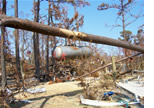Response to Hurricane Katrina
ALERT
Boil Drinking Water
If your water may not be safe, bring drinking water to a rolling boil for 1 minute to kill water-borne diseases.
More information | en español
Hurricane Recovery
Getting help
Giving help
Missing people
General information
All -![]()
Other Agencies
10/21/05
 EPA has conducted more than 3,200 incident responses since deploying emergency response personnel following the destruction left by Hurricane Katrina along the Mississippi and Alabama coastline. An incident response is defined as an investigation of a National Response Center Report, contacting facilities, and reporting hazmat debris while conducting land or water assessment in the affected areas.
EPA has conducted more than 3,200 incident responses since deploying emergency response personnel following the destruction left by Hurricane Katrina along the Mississippi and Alabama coastline. An incident response is defined as an investigation of a National Response Center Report, contacting facilities, and reporting hazmat debris while conducting land or water assessment in the affected areas.
Assessment and Removal Team Activity
EPA is operating under three divisions that were formed to address Hancock (Division A), Harrison (Division B), and Jackson, Mississippi Mobile and Baldwin, Alabama (Division C) counties, which are the most affected areas along the coast. The U.S. Coast Guard (USCG) is serving as liaison between EPA and the three divisions. Coastal MS experienced storm surge flooding of 18 to 22 feet above normal tide levels and significant rainfall amounts during Hurricane Katrina.
Division A – Hancock County, Miss.
Team 1 continued operations at a Hancock County vehicle maintenance facility and addressed diesel fuel in a draining ditch where a 5,000-gallon tank had leaked. Personnel pushed floating product to one end of the ditch to allow removal using a vacuum truck.
Team 2 conducted assessment and removal activities in Waveland, while Team 3 also worked in a separate area of Waveland.
Division B – Harrison County, Miss.
Teams 1 and 2 conducted assessment activities in the Gulfport/Biloxi area, while Team 3 conducted removal operations based upon previous item reports.
Division C – Jackson County, Miss., and Baldwin and Mobile Counties, Ala.
Team 1 recovered a 55-gallon drum from Dauphin Island, numerous small items from Baldwin Count, and hazardous household waste in Mobile County. All recovered items were transported to the collection point in Bayou La Batre.
Team 2 continued to monitor the segregation of hazardous materials at various debris segregation and reduction sites and landfills in Jackson County.
Vessel Group
In Port Chickasaw, the team recovered 400 gallons of oily water from a vessel. The team also recovered 3755 gallons of fuel and 10 batteries in Bayou Portage. In Bayou Caddy, the team recovered 250 gallons of fuel.
Air Monitoring
The Air Monitoring Support Team is collecting PM 2.5, PM 10, with metals analysis and asbestos at three permanent sampling sites in Pascagoula, Gulfport and Stennis Air Bases. Additionally, the VOC, SVOC, carbonyl, and hexavalent chromium samplers are being collected at these sites.
The team is also operating three sites near larger burn area. They are sampling for PM 2.5, PM 10 and asbestos. The team has collected a total of 66 PM 2.5, 66 PM 10 and 37 asbestos sample, along with 17 VOC, 17 SVOC, 17 carbonyls and 17 hexavalent chromium samples. All Air data results will be coordinated with EPA’s Emergency Response Team.
NPL Sampling Team
Field sampling for the NPL study is completed and the data was sent to the laboratory for analysis. Once the data is received, it will undergo Quality Assurance Review and the results will be reported to project leaders.
Water Systems
An EPA mobile drinking water laboratory, stationed in Gulfport has processed more than 1,188 drinking water samples and continues to analyze new samples each day.
The Waste Water Treatment situation continues to improve. In Mississippi, the Delisle Waste Water Treatment Plant is now operating normally and East Biloxi is still operating primary treatment only. The state of Alabama reported that Dauphin Island's Wastewater Treatment plant is now operating at limited capacity. This means that all municipal wastewater treatment facilities in Alabama and Mississippi are now considered to be operational.
Public Outreach
Community Involvement Coordinators continue to coordinate collection of hazardous household waste. Citizens returning to their homes will be able to drop off any paints, solvents or other hazardous materials on specific day.
• Emergency Fuel Waiver for AL, FL, LA, MS
![[logo] US EPA](../gif/logo_epaseal.gif)